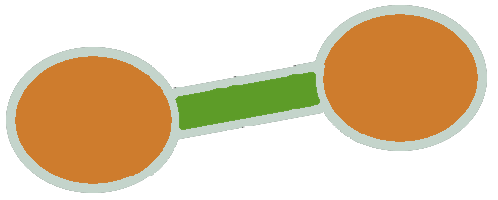Ninatoka
 concept
conceptSecretin
Secretin has 3 main functions: regulation of gastric acid, regulation of pancreatic bicarbonate, and osmoregulation. Regulation of Gastric Acid Secretion and Pancreatic Bicarbonate The major physiological actions of secretin are stimulation of pancreatic fluid and bicarbonate secretion. S cells in the small intestine emit secretin. Gastric acid stimulates secretin release, allowing movement into the duodenal lumen. Secretin causes an increase in pancreatic and biliary bicarbonate secretion and a decrease in gastric H+ secretion. Secretin stimulates the secretion of bicarbonate-rich pancreatic fluid.[11] Secretin enters the intestinal lumen and stimulates bicarbonate secretion, ultimately neutralizing gastric H+, which plays an essential role in fat digestion by creating a more neutral (pH 6 to 8) environment. H+ and fatty acids in the duodenum regulate secretin release. Secretin neutralizes the pH in the duodenum by optimizing the functionality of pancreatic amylase and pancreatic lipase. (1) Via the second messenger action of cAMP, bicarbonate release causes neutralization of the acidic environment, thus establishing a pH favorable for the action of digestive enzymes.[12] Secretin increases bicarbonate secretion from duodenal Brunner's gland as well; this mechanism buffers the acidity from chyme and reduces secretion of acid by parietal cells. Osmoregulation Water homeostasis is crucial in maintaining the balance between water intake and excretion in the body. Osmoregulatory functions of secretin in the brain are similar to those of angiotensin II.[13] Secretin is found in the magnocellular neurons of the paraventricular and supraoptic nuclei of the hypothalamus. In states of elevated osmolality, secretin is released from the posterior pituitary - this causes activation of vasopressin release in the hypothalamus. Vasopressin affects the collecting ducts, where it induces the insertion of aquaporin 2 water channels on the apical membranes of these cells.[14] Secretin has been shown to induce an increase in urinary volume.
Ref:
DiGregorio N, Sharma S. Physiology, Secretin. [Updated 2022 May 8]. In: StatPearls [Internet]. Treasure Island (FL): StatPearls Publishing; 2022 Jan-. Available from: https://www.ncbi.nlm.nih.gov/books/NBK537116/
Join Ninatoka!!
NinatoKa's goal is to support you as a therapist in unravelling the illness pathway from symptoms to cause, and to help you detect potential interventions.
Go to Explore to start your discovery!
Go to Learn to scroll through newly added data.
Go to Contribute to contribute to the Ninatoka database.
You can rate content up or down and add comments if you agree or disagree.



